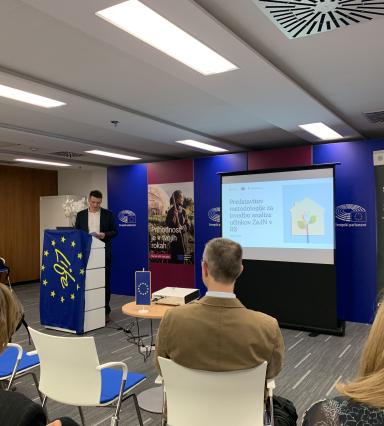
Benefits for the public sector
In recent years, global agreements like the Paris Agreement on Climate Change (2015) have promised to act on issues that include halting deforestation and forest degradation. Public authorities can act in different ways to help achieve this, including through their purchasing policies. And that is where FSC is able to help.
By making FSC certification part of their purchasing policy and practice, public authorities can ensure that suppliers of forest products meet the most comprehensive social and environmental requirements in the world. This presents an immediate opportunity to make a difference.
The power of public procurement
Public spending represents between 15 and 30% of the gross domestic product in many countries, and is a powerful force for taking action against deforestation, forest degradation and climate change. We have seen many public procurement policies and practices emerge in recent years. Often starting at the local level, these approaches have become embedded in the national policies of a growing number of countries.
But increasingly, governments are embracing the holistic concept of sustainable public procurement – one that is embodied by FSC certification.
By buying FSC-certified products – which range from paper and office furniture, to timber for construction projects – public procurers support the move towards responsible public production and consumption patterns, setting an example for consumers.

What can be included in GPP tender?
There are various categories of green public procurement (GPP) and just as many forest products that you can source. While the typical categories of forest-based products incorporated in the GPP procurement policies include office paper and other paper products and office furniture, you can include many others!
Any material of product coming from an FSC-certified forest can in teory be FSC-certified. This means that public institutions can also require FSC certification for products such as textiles and clothing, rubber shoes, car tyres, toilet paper, and so on. Have a look at the wide spectrum of possible FSC-certified products below.
Responsible procurement process
The world relies on forests in many ways. While providing a livelihood for millions of people, and a source for raw materials for all of us, they also play an important role in helping us to control and adapt to climate change, as well as protect and enhance biodiversity, soil fertility, and clean, fresh water. Read more about many benefits from the forests.
In particular, deforestation and forest degradation together form one of the main contributors to global warming. Stopping this trend is essential for all of these reasons, which is why business-as-usual is no longer an option.
Be clear in the tender
The first step is to be clear in the tender formulation. Insist that bidders confirm they are in compliance with the rules of the forest certification schemes they intend to refer to for proving compliance with the relevant technical specifications.
Use the FSC database
The second step is to control the information given by these bidders with the use of the FSC public certificate database. Our database can help you confirm that a certain bidder is certified, and further details for which products does a company hold its FSC certification.
Check the claims
The third step is to control the claims that come with the actual goods, because most FSC certificate holders trade in both certified and non-certified products. The control starts with checking whether the invoices have valid FSC claims. The public certificate database is a good way to check this.
FAQs
Is FSC more expensive? How can specific requirements for sustainable forest management be set by procurers? How can this be applied to construction projects? All of these questions, and more, are answered below.
-
How can FSC certification prove compliance with public procurement requirements?
In the European Union, new public procurement directives apply from 18 April 2016. These allow for the inclusion of environmental – and to some extent social – requirements in public procurement.
The directives, about which FSC has produced an introduction and clarification, also allow for the use of specific labels as evidence of compliance with sustainable procurement policies.
Further to this, the World Trade Organization’s revised Agreement on Government Procurement (AGP) covers government purchase of goods, services, and construction work.
Article X – Technical Specifications and Tender Documentation, which came into force in April 2014, introduces the explicit right of procurers to apply “technical specifications to promote the conservation of national resources or protect the environment”.
Obviously this does not include explicit approval for including social elements of sustainable production. But according to a legal review of this new AGP, “there seems to be no fundamental reason why social criteria should be treated differently”(Lucia Tosoni, in EPPPL - European Procurement & Public Private Partnership Law Review, nr. 1 1, 2013, page 47).
A number of countries have therefore included the requirement of certified wood-based products in their procurement guidelines. Some have set up a system to assess the performance of forest certification schemes. The Netherlands and United Kingdom stand out with their detailed verification methods, including stakeholder consultations, implemented by independent assessment bodies (TPAC in the Netherlands and CPET in the UK) every five years.
In other countries, government bodies assess compliance with legal and sustainability criteria (e.g. in Germany, Denmark, Belgium, Luxembourg, Australia, Austria, Croatia, Slovenia, Finland, Italy, Spain, Sweden and Switzerland).
In the countries mentioned above, FSC certification is specifically mentioned as acceptable proof for compliance with their public procurement requirements. Many other countries are less specific or lack requirements.
-
How do you set your requirements for responsible forest management?
Setting your own specific requirements for responsible forest management can be problematic. Procurers are not allowed to specify in which countries the timber has to be harvested, so their technical specifications have to encompass all relevant forest types and social situations.
Procurers can also refer in general to “responsible forest management” and point at one or more inter-governmental decisions in which this concept is being defined. But those descriptions are usually rather general. And they still have to take into account the risk of illegal logging and trade.
For that reason it is practical to, on the one hand, be as specific as possible with qualifications about what responsible forest management means to you and, on the other hand, mention the specific forest management standard/label(s) for which you provide evidence of compliance (while never forgetting to allow 'equivalent' evidence, to avoid violation of procurement laws).
Ambitious procurers can use the FSC Principles and Criteria requirements as the basis for their description. You could for example require that at least 70% of forest materials have to be from responsibly-managed forests complying with these requirements, and the rest to be from recycled origin and/or controlled wood. With such requirements spelled out, it is logical to refer to FSC (or 'equivalent') as the evidence of compliance.
-
How do you address the limitations of lifecycle assessment with FSC certification?
Lifecycle assessment (LCA) is a widely used tool for understanding the environmental impacts of production, use, and discharge of goods. But it has limitations when forestry, fishing, mining, or agriculture are at the start of the supply chain. It also does not address social issues.
FSC calls upon all those who apply, use, or require LCA to recognise its limitations, and to address these with guarantees that negative impacts beyond the scope of LCA are prevented or minimised. For paper and other wood-based products, FSC certification is the best way of doing this.
-
How can you build green with FSC-certified wood?
Wood is an important component in many public projects, such as buildings, houses, harbours, waterworks and railways.
Sourcing the massive amounts of wood needed for public projects from responsibly-managed forests can make a considerable environmental and social difference. Construction firms have to be FSC-certified in order to be able to claim the use of FSC-certified materials.
-
How can I start the procurement process?
FSC provides added value, not added cost. FSC products are not necessarily more expensive. When there is a price difference it is often marginal. And FSC certification brings many benefits to our certificate holders, such as a reduction in costs and increased profits, while also allowing greater efficiencies in work processes by choosing a lesser known timber species.
Higher prices for FSC timber typically happen due to direct competition with forest operations that are undertaking illegal activities. Before making a purchase, procurers should ensure that the forest operation:
- did not remove more trees than permitted or is ecologically acceptable
- did not evade taxes
- did not ignore the rights of indigenous peoples
- ensured workers were paid a fair wage in safe conditions.

